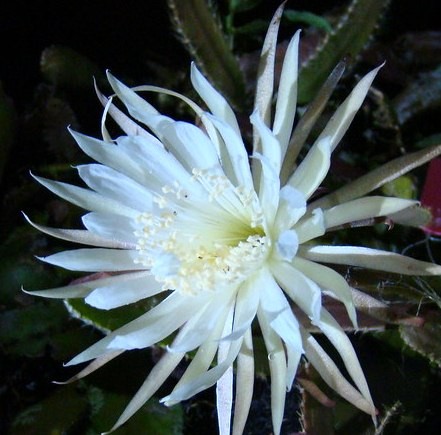Strophocactus wittii
(Strophocactus wittii)

Description
Strophocactus wittii, synonym Selenicereus wittii, known as the Amazon moonflower, is a species of plant in the genus Strophocactus in the cactus family (Cactaceae), and is one of several species commonly called "moonflowers". It was first described in 1900 and is one of three species of cactus found in the central Amazon basin. It grows epiphytically on the trunks of trees in seasonally flooded forests of the Amazon basin, which is regularly flooded for a few weeks each year. During this time, the seeds spread through the water, which is unique within the cactus family. Strophocactus wittii grows as a epiphyte, creeping and climbing up trees. The richly branched, leaf-like, flattened stems are phylloclades, and are pressed close to the tree trunks of their carriers and form aerial roots along their midrib. When exposed to direct sunlight, the elliptical to lanceolate, dark green shoots turn dull red due to strong betalain pigmentation and are therefore clearly visible from a distance. Each segment is up to 60 cm long and 6–14 cm wide, but only 2 to 4 mm thick. Their edges are slightly notched, and are covered with white woolly areoles about every 8–10 mm. Up to 20 needle-shaped, whitish spines up to 12 mm long arise from the areoles. Strophocactus wittii is common in the rainforests of the central Amazon basin along blackwater rivers. There the species grows in abundance in the crown area of the temporarily flooded floodplain forests. The distribution area extends along the Rio Negro and Rio Japurá in Brazil over the Río Vaupés, Río Apaporis and Caquetá in Colombia to northeast Peru in the Loreto region to the city of Iquitos and probably includes the southern area of the Amazon basin in Venezuela. In addition to Strophocactus wittii, only the two cactus species Rhipsalis baccifera and Epiphyllum phyllanthus grow there.
Taxonomic tree:







